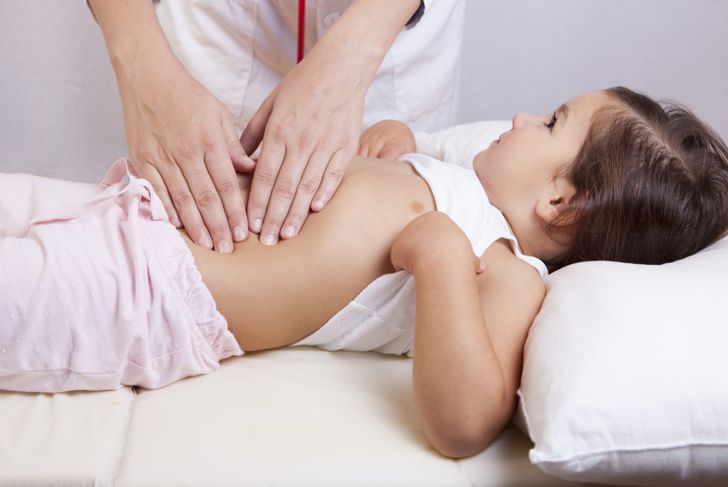Appendicitis — the inflammation of the appendix — is an emergency and often leads to the removal of this slim organ that runs into the large intestine and along the abdomen. If the appendix ruptures, fecal matter can enter the abdomen, potentially spreading a life-threatening infection throughout the body. Appendicitis can occur in any age group, but older people are much more at risk for a rupture than younger individuals. The early symptoms of appendicitis are mild and may be difficult to spot until the condition has progressed.
Pain Close to the Navel and Upper Abdomen
Pain near the navel or belly button is the first notable sign of appendicitis. It generally circles the navel in the beginning, and then, as the symptoms worsen, begins to spread throughout the abdomen. The pain typically starts with short bouts of achiness. As time progresses, the duration of each bout lengthens, as does its intensity. What was once described as sore, achy, or tender soon turns into a stabbing pain that could be warning of an impending rupture.
Loss of Appetite
A person experiencing the initial symptoms of appendicitis is unlikely to feel like eating. While this symptom is far from unique to appendicitis, coupled with one or more other symptoms it is significant. Also, when eating and drinking become difficult, dehydration can set in fairly quickly, which can exacerbate the condition.
Nausea
Many individuals with appendicitis experience a few days of nausea with varying degrees of severity. Depending on how serious this symptom becomes, vomiting can also occur. Often, this symptom confuses people, who assume they have the stomach flu and may, therefore, put off seeing a doctor.
Swelling
Inflammation around the appendix can make the abdomen swell in people with appendicitis. This swelling and pain can result in a need to pass gas or bowel movements, but an inability to do so.
Fever
Having a fever is a sure sign that the body is trying to fight off an infection or other illness. The symptom occurs when dead organisms release chemicals into the blood. This prompts action from the part of the brain that regulates temperature, and it increases the body temperature. However, a lack of a fever does not disprove appendicitis and should not keep an individual with abdominal pain from seeking medical help.
Gas
Inability to pass gas is not always a sign of appendicitis. Anytime a person overindulges in greasy, heavy food, the body can struggle to pass gas, resulting in bloating. However, if this type of pain does not subside overnight or throughout the next day, and if additional symptoms of appendicitis are present, an individual should see a doctor promptly.
Pain with Movement
Particular movements or motions of certain body parts may be painful if you have appendicitis. While the majority of the pain is likely to be centered around the navel and the upper abdomen even when sitting perfectly still, moving around can increase the pain. Motions of the legs and arms can also increase the pain, as can coughing or sneezing. Typically, the pain subsides a bit when the motion ceases even though it may never completely go away.
Rebound Tenderness
Rebound tenderness is a symptom of appendicitis. Doctors use it as a test when attempting to diagnose their patients. When, after pushing carefully on the abdomen in the lower-right area, the patient experiences pain when pressure is released, rebound tenderness is present. This is a significant sign that the individual is experiencing more than just a stomach ache.
Diarrhea
Diarrhea is one of many symptoms of appendicitis, though it is rarely closely linked to the condition. Diarrhea causes loose and watery bowel movements that may expel with more than the ordinary force. Over-the-counter medications can ease this symptom, but if other symptoms of appendicitis are also present, an individual should still seek medical attention. Easing this symptom will not stop the primary issue.
Constipation
The opposite of diarrhea, constipation, can also occur in a person with appendicitis. The longer a person goes without passing stool, the more compacted the stool may become. Stool softeners can help trigger a bowel movement, but as with antidiarrheals, it is important not to discount the symptom simply because medication has alleviated it.

 Home
Home Health
Health Diet & Nutrition
Diet & Nutrition Living Well
Living Well More
More




















